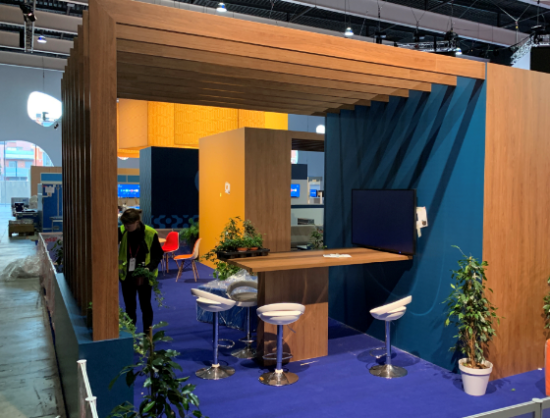Why are huddle spaces so important and relevant now? Because we’re no longer in the age of “oil and water at work.” What do I mean by that? Well, since people started working together in offices, let’s say for the past 100 years, meetings and collaboration efforts have had two primary ingredients: people and tools. People arrived with their ideas and their discussions. The tools evolved over time, from pencil and paper to telephone, to PowerPoint. For all intents and purposes, these tools remained tools, useful in their capacity but in no way integrated with their human operators. It simply was not possible to do so. Humans and tools existed side-by-side, like oil and water. They could never truly blend productively.
But we are now in a different age, in which our tools are becoming capable of collaborating with us more fully. Concepts like artificial intelligence and virtual reality take us into spaces where tools and humans don’t merely co-exist; they start to collaborate as one. Tools are now beginning to contribute to the quality of the interaction, rather than just being, well, tools. The software, the hardware, the floor space, and the furniture – these are all part of the huddle space, and they all contribute to learning, communication, and collaboration in a manner very different from the meeting rooms and offices of previous generations.
Huddle Spaces for Collaboration
Huddle spaces are necessary because they match the pace, mindset, and style of how people want to work now. The growing transformation to team collaboration means small groups working together more frequently and in an ad-hoc fashion. We need fewer designated places with cold tools and more dynamic spaces where people and warm tools can work together, providing, for example:
- Fast, one-button-to-join experiences
- HD video that helps see everyone face-to-face and builds a rapid connection with virtual teams
- Virtual whiteboards for co-creating that next big idea with the whole team – wherever they are
- Seamless transition from mobile device to huddle space device if you are running late, or just on the move
- Easily shared content with no dongles or connectors required
- Automatic removal of background distractions
- Artifacts of the meeting (recording, whiteboards, documents) saved in a shared virtual workspace to ensure work easily continues
This is how the warm tools of the huddle space actively and interactively support and coordinate meetings, brainstorming sessions, your team’s dynamic working activities – wherever and whenever they occur. This is what today’s pace of business demands. But it’s also what smart, motivated employees expect. They seek a fulfilling work environment that matches their abilities and drive.
Huddle spaces are important because they answer a demand and provide a better end product. They are relevant because the y use mobile cloud-based technologies the way they were meant to be used; not as an afterthought, but as the beating heart of a dynamic team.
y use mobile cloud-based technologies the way they were meant to be used; not as an afterthought, but as the beating heart of a dynamic team.
The organizations that have tuned in to this concept are redesigning their physical floor plans to make huddle spaces and connection points more available. Vibrancy and immediacy are the dominant themes. Elimination of traditional barriers to productivity such as overbooked meeting rooms, uncomfortable lighting, and incompatible schedules are the currency. And full use of peoples’ creativity and synergy represent the payoff.
This is what the future of business looks like. No more “oil and water,” but instead, a fusion of human, technology, and environment, and a redefinition of time and space for busy people and their projects.
Do you want to learn more? Check out our upcoming webinar, Unpacking the Power Behind Huddle Spaces, here, happening Thursday February 14, 2019, and available on demand afterward.

CONNECT WITH US